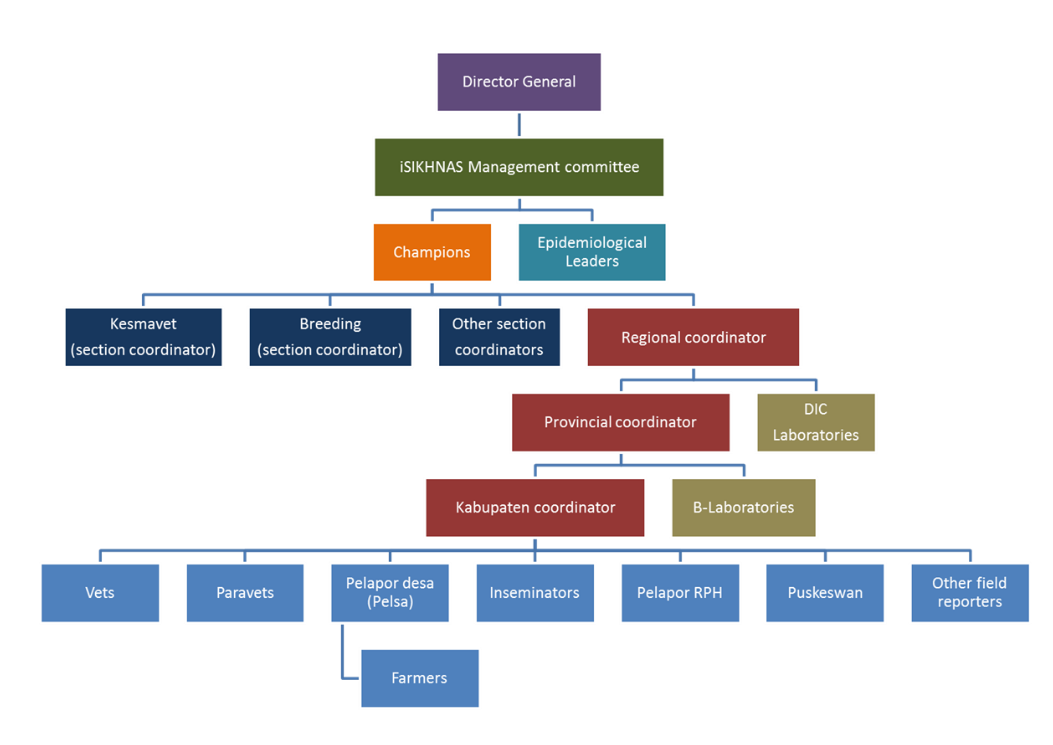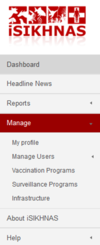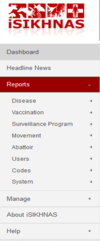Manual for Coordinators
Daftar isi
- 1 iSIKHNAS Co-ordinator Manual
- 1.1 Introduction
- 1.2 Roles and responsibilities:Regional and Provincial coordinators
- 1.3 Roles and responsibilities:District coordinators
- 1.4 Using the iSIKHNAS Website for Administration and Monitoring
- 1.5 Manage
- 1.6 Reports
- 1.7 Understanding your role and the tools available to help you
- 1.8 District coordinators
- 1.9 Key coordinator functions and challenges
- 1.10 Administration
iSIKHNAS Co-ordinator Manual
Introduction
Basic founding principles of iSIKHNAS
As any system matures, it is valuable to keep in mind of the founding principles upon which it was designed and built. iSIKHNAS will become the backbone of all Indonesia's efforts to improve animal health, secure the livelihoods of livestock owners and ensure good management of production and food supply in the country. It was designed and built in careful collaboration with a wide range of dedicated staff working for improved animal health in many different regions.
iSIKHNAS was designed so that it should;
- be flexible, user-friendly, sustainable and bring benefit to all of its users.
- meet the needs of users from as many sectors of the livestock industry as possible.
- use appropriate technology and not require great change to existing systems.
- integrate existing systems to facilitate the collaborative use of data.
- simplify and ease the data entry burden and ensure the rapid availability of data from the field.
- recognise the vital contribution each user plays in the transfer of information.
- provide benefit and good service to all its users.
- make all data widely and freely available for decision making at all levels and for a multitude of purposes.
As a system coordinator, your leadership and guidance will help to ensure these principles remain fundamental to the system and its users. iSIKHNAS is not a data collection tool but an integrated system which will empower its users with access to relevant, up to date information rapidly and cheaply so that they can concentrate on core activities. As a coordinator, you are part of the new animal health service which is built on good relationships, clear and timely communication, leadership and support.
Whilst much effort has been gone into minimising change, the new iSIKHNAS will inevitably bring about some change for all staff. Every coordinator will have to be equipped to chaperone newcomers to the system, assist in training and system operations, offer support by telephone and email, monitor reporting, errors and address weaknesses. Staff should be congratulated and thanked, given positive reinforcement for their successful engagement with the system and assisted wherever there are difficulties. Collaboration with livestock owners and their communities should give benefit or have positive outcomes at every interaction. At every step, we should remember that this is a system for providing a service to all its users equally. If everyone contributes with this in mind we will all benefit.
iSIKHNAS coordination and management model
The management of the iSIKHNAS animal health information system will be overseen by a committee appointed by the Director General of Animal Health and Livestock Services. This committee will comprise senior representation from key stakeholder groups including Production, Veterinary Public Health, Drugs Administration and Quarantine, for example.
The management committee will be supported by the technical expertise provided by the System Administrators (Champions) and the Epidemiology Advisory Panel (Epi Leaders).
Key subsectors involved in certain specialist areas such as Production and Public Health will appoint coordinators to lead the oversight and training of officers involved in these activities.
Each administrative level will appoint a coordinator appointed and that person will be given detailed training in the use and oversight of the system. This will mean that every region, province and kabupaten will have a designated iSIKHNAS coordinator. Some areas may choose to share the coordination between two or three staff members to ensure that the system is monitored and users are supported at all times.
Roles and responsibilities:Regional and Provincial coordinators
Regional and provincial coordinators play an important leadership, support and system oversight role.
Roles and responsibilities:District coordinators
District coordinators play a vital leadership, support and system oversight role at the district level. They train, motivate and support their dinas staff and all other users enabling everyone to work efficiently and effectively.
Using the iSIKHNAS Website for Administration and Monitoring
A few important things to remember about the website.
Security
- Every user must be registered before they can be given access (a password) to the iSIKHNAS website. The password ensures the website remains as secure as possible. The data on the website should never be shared with anyone without authorisation.
- The website automatically logs a user out after a certain time of inactivity. So if you leave your desk for a while and return, you will probably find that you will have to log back in to the website. This is done for security reasons.
View
- Every user will have a different view of the website and different access rights to parts of the website according to their assigned User Type and Location.
- This acts to simplify the site for users and adapt it to suit each user's core interests and responsibilities.
- The site will change over time. Features will be improved, new features added and new reports created - users should be prepared to adapt to the changing face of the system.
Manage
The Manage menu allows coordinators to create, update and manage users and special programs such as for vaccination and surveillance, as well as managing infrastructure and location data.
Reports
The Reports menu provides access to the database for animal health and staff monitoring purposes. It allows coordinators to view reports and analyses in various formats, as well as download raw data.
Understanding your role and the tools available to help you
District coordinators
District coordinators have many responsibilities but iSIKHNAS provides tools to support this key role.
Using iSIKHNAS data
- Changes you can expect over the coming 12 months
- Increased data as roll out takes effect
- Website changes
- Increase in the number of reports, charts and other analyses available
- New mapping capabilities
- How to ask for a new report to be made
- Defining your question
- Making sense of the outputs
- Printing reports, editing Excel files
To monitor and support staff
- Reports available via the website
- How to interpret the data
- How to support staff to encourage improved work and service
- How to set realistic goals and see if your team are achieving them
- Other ways to use data
- SMS alerts
- Routine reports via email
- Monitoring the system
- Building a routine for your monitoring role
- Reacting to problems
- Dealing with questions, requests, problems, flaws
- Giving and sharing feedback
To monitor and improve animal health
- Reports available via the website
- How to interpret the data
- Using the most valuable parameters
- Other surveillance tools
- Pattern detection
- Technical courses for staff development
- Other ways to use data
- SMS alerts
- Routine reports via email
Key coordinator functions and challenges
- Using the data to support your monitoring role
- Helping others to use the data more effectively for better animal health outcomes
- Understanding and respecting the management and support structures
- Understanding the roles and responsibilities of everyone involved
- Providing recommendations for policy changes, technical issues and assistance with analysis
- How to motivate and reassure staff
- Developing a culture of ongoing training
- iSIKHNAS modules
- Staff development courses available
- Developing a strong network of village level reporters
- Signs recognition training
- Developing respect for their role and a sense of pride the work they do
- Keeping people involved
Administration
Interface
Menu system
Menu system by Group User
News stories
Reference codes
- Diseases
- Species
- Signs
- Animal types
- Syndromes
- Laboratory
- Testype
- Laboratory sections
- Submission reasons
- Submitter types
- Specimen forms
- Age units
- Test methods
- Test targets
- Qualitative findings
- Units for quantitative findings
- Uncertainty types
- Test results
- Drugs
- Drug class
- Drug types
- Drugs
- Production
- Straws
- Colour
- Animal purposes
- Event types
- Infrastructure types
Excel metadata
· Import jobs
· Import tables
· Import fields
· Field types
Metadata for reference export
·
Business Rules
·
Reports
· Reports
· Saved reports
· Report subscriptions
· Field types
· Regenerate reports for PL/R
Templates
· HTML templates





